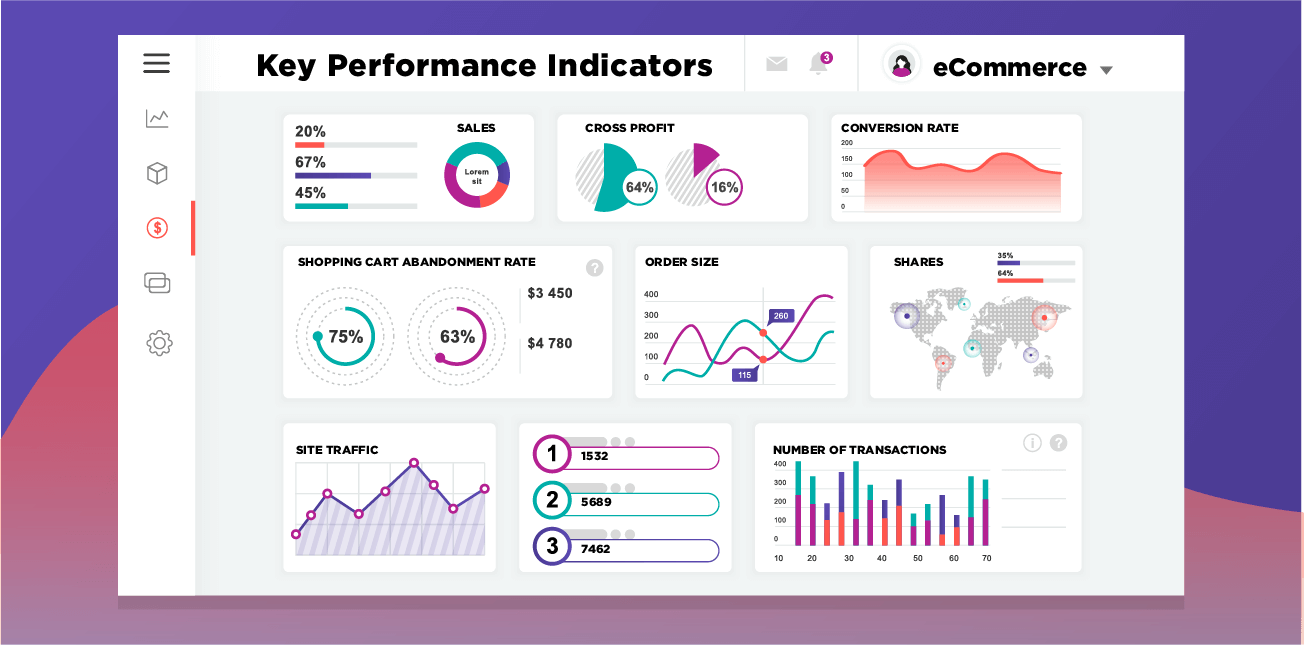Hello!
Though sales is the ultimate metric that all ecommerce brands want to track and improve over time, focusing on sales alone is not the best way to find areas of improvement.
 If you want to grow sales over time and sustain that growth, you’ll need to track the right ecommerce KPIs, metrics, and benchmarks if you want to make strategic changes.
If you want to grow sales over time and sustain that growth, you’ll need to track the right ecommerce KPIs, metrics, and benchmarks if you want to make strategic changes.
But with so many ecommerce KPI benchmarks and metrics to track, it can be difficult to determine which you should be focusing on. In this post, we’ve put together a list of the key ecommerce metrics and KPIs, and we’ll explain what they can help you understand about your business.
Ecommerce KPI to track – Conversion Rate
The conversion rate refers to the percentage of your e-commerce site visitors who took a desired action on your site. Though conversions are typically associated with sales, the conversion rate is not always used to measure the number of people who make a purchase.
Conversions can also refer to email subscribes, e-book downloads, lead form fills, etc.
Basically, the conversion rate is one of the e-commerce metrics that helps you better understand how effective your site is at getting visitors to take action. High conversion rates suggest that your site is doing a good job at encouraging passive visitors to act.
 If you find that you have particularly high conversion rates on a certain page, you may want to revisit the page design and content to see if any elements may be contributing to these higher conversions.
If you find that you have particularly high conversion rates on a certain page, you may want to revisit the page design and content to see if any elements may be contributing to these higher conversions.
On the other hand, low conversion rates may suggest that you need to tweak certain site elements to improve site activity. If you’re tracking sales and find you have low conversions, this may suggest that the checkout process is difficult to complete. Or it could point to issues with your product descriptions or images.
When choosing which actions to measure for conversions, you’ll want to consider your overall e-commerce business objectives. That doesn’t mean that purchases are the only conversion you’ll want to track.
For instance, let’s say that you have a buyer’s guide that you’ve created for the holiday season. Downloading this buyer’s guide could lead to the ultimate conversion – a sale. Therefore, you may want to track how many visitors download the guide over time.
Ecommerce KPI to Track – Shopping Cart Abandonment Rate
Unfortunately, every ecommerce business is familiar with shopping cart abandonment. Visitors come to your site, put items in their online shopping cart, and then leave your site without finalizing their purchase.
The shopping cart abandonment rate is one of the most important ecommerce KPIs to measure as it signals to your business that some changes need to be made if you want more visitors to follow through with their purchases.
 Though cart abandonment is a natural part of running an e-commerce business, unusually high cart abandonment rates may suggest that there are some issues with your checkout process.
Though cart abandonment is a natural part of running an e-commerce business, unusually high cart abandonment rates may suggest that there are some issues with your checkout process.
If the process is complex or takes too long, visitors may be inclined to leave before they finalize their purchase. For instance, if you require every visitor to make an account on your site before buying, many people may drop off before making a purchase. Try providing a guest check-out option and see if your abandonment rates decline.
 It’s important to note that the checkout process is not the only thing that may be impacting your cart abandonment rate. Some other issues may include:
It’s important to note that the checkout process is not the only thing that may be impacting your cart abandonment rate. Some other issues may include:
- Your site does not have any security badges or trust seals that suggest your site has a secure checkout process.
- Your brand has not followed through on a promise you’ve made such as free shipping or discounted rates.
- There are unexpected costs on the checkout page such as a shipping and handling or service fee.
By tracking your shopping cart abandonment rate over time, you can keep an eye on how many visitors are leaving your site before making a purchase. Then, you can work to test different strategies to help reduce the abandonment rate and improve sales conversions.
Ecommerce KPI to Track – Average Order Value
Encouraging customers to spend more during their visit to your site is one of the best ways to increase revenue over time. If you want to determine just how good your e-commerce site is at encouraging more sales, you’ll need to track the average order value.
 The average order value tells your company how much on average a customer will spend on a single order. The higher your average order value, the more income your store generates on each order.
The average order value tells your company how much on average a customer will spend on a single order. The higher your average order value, the more income your store generates on each order.
Once you determine your average order value, you can start focusing on strategic ways to increase this value over time. One way to do this is to upsell.
You can upsell on the product page by offering product bundles that include other similar products or recommending complimentary products right on the page. In addition, during the checkout process, you can encourage the customer to purchase a premium, more expensive version of the product that is already in their cart.
Ecommerce KPI to Track – Customer Lifetime Value (CLV)
How much value does one customer provide over their lifetime? Customer Lifetime Value, or CLV, is the estimated revenue that a typical person would spend over their lifetime as a customer of your brand.
 This is one of the key e-commerce metrics that helps your business get a better idea of just how valuable a customer is over the course of their relationship to your company.
This is one of the key e-commerce metrics that helps your business get a better idea of just how valuable a customer is over the course of their relationship to your company.
If you find that your customer lifetime value is rather low, you’ll need to find ways to strengthen your relationships with customers. One way to do this is by establishing a customer loyalty program.
By rewarding your best customers for being loyal to your brand, your brand is not only building a relationship with these customers but also encouraging repeat sales. Great content marketingand social media engagement can also help you improve relationships with your customers which can boost CLV over time.
This ecommerce KPI can help you estimate marketing costs over time as well as provide valuable information for your customer acquisition strategy. For example, Google Analytics allows you to see the CLV for customers based on the channel that they found your site through. After determining which channels are helping you get the best customers, you can focus on investing more into these channels over time.
Ecommerce KPI to Track – Customer Acquisition Cost (CAC)
 The customer acquisition cost, or CAC, is one of the most important e-commerce KPI benchmarks that your brand can measure.
The customer acquisition cost, or CAC, is one of the most important e-commerce KPI benchmarks that your brand can measure.
CAC lets you know how much you are spending on acquiring each customer. This metric is determined by looking at your total marketing spend and seeing how it breaks down per each new customer acquired over time.
Why is customer acquisition cost important? Well, reducing costs plays a significant role in helping your e-commerce brand improve revenue and grow over time. However, you can’t reduce your marketing costs if you do not keep track of them over time.
Once you have identified how much it costs to acquire a new customer, you can work to optimize your marketing spend by investing in those channels that provide the best return on investment for your brand.
Ecommerce KPI to Track – Website Traffic Metrics
 Measuring website traffic goes beyond just tracking how many visitors end up on your site. There are a number of website traffic metrics that can help you better understand how effective your website is at encouraging sales conversions:
Measuring website traffic goes beyond just tracking how many visitors end up on your site. There are a number of website traffic metrics that can help you better understand how effective your website is at encouraging sales conversions:
- Traffic Referral Sources Do you know which channels are bringing the most traffic to your site? By tracking traffic referral sources over time, you can see which channels are bringing in the most (and best) customers. Then, you can invest your time and budget into the channels that provide the highest return on investment.
- Time on SiteWhen it comes to e-commerce sites, the more time visitors spend on the site, the better. Longer site times suggest that visitors like what they see on your site and want to spend more time browsing.
- Page Views Per VisitThis metric gives you a better idea of how many pages the average visitor is looking at once they land on your site. This can help you understand how well your content is resonating with your target audience.
- Returning VisitorsYou can also track how many of your site visitors are unique and how many are returning. If you notice that most of your site visitors are new, this might be a signal that your site could be more user-friendly.
All of these site metrics can help you better understand how visitors use your site and what they do once they get there. If you find that visitors are not taking the actions you want them to, you should revisit your site’s design and content to ensure that it is optimized for conversions.
Also read:
- Google Faces EU Antitrust Complaint Over AI Overviews Feature
- Every Member of 23andMe's Board Except the CEO Just Resigned in Disgust
- Meta Halts Political Ads in EU from October, Citing TTPA’s “Unbearable Complexity”—Google Precedes the Move
Ecommerce KPIs – Final Takeaways
 Without e-commerce KPI benchmarks and metrics, it can be difficult to measure your brand’s progress toward business goals over time.
Without e-commerce KPI benchmarks and metrics, it can be difficult to measure your brand’s progress toward business goals over time.
Rather than making decisions based on gut instinct or personal preference, you can use the e-commerce KPI examples above to help you better understand your strengths and areas of opportunity.
Then, you’ll be able to make more strategic and informed decisions about your business.
Thank you!
Join us on social media!
See you!






